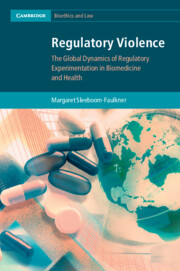Refine search
Actions for selected content:
2 results
2 - Regulatory Boundary-Work in a Global Arena of Regulatory Capitalism
- from Part I - Regulatory Capitalism
-
- Book:
- Regulatory Violence
- Published online:
- 21 May 2025
- Print publication:
- 22 May 2025, pp 39-64
-
- Chapter
-
- You have access
- Open access
- HTML
- Export citation

Regulatory Violence
- The Global Dynamics of Regulatory Experimentation in Biomedicine and Health
-
- Published online:
- 21 May 2025
- Print publication:
- 22 May 2025
-
- Book
-
- You have access
- Open access
- Export citation
